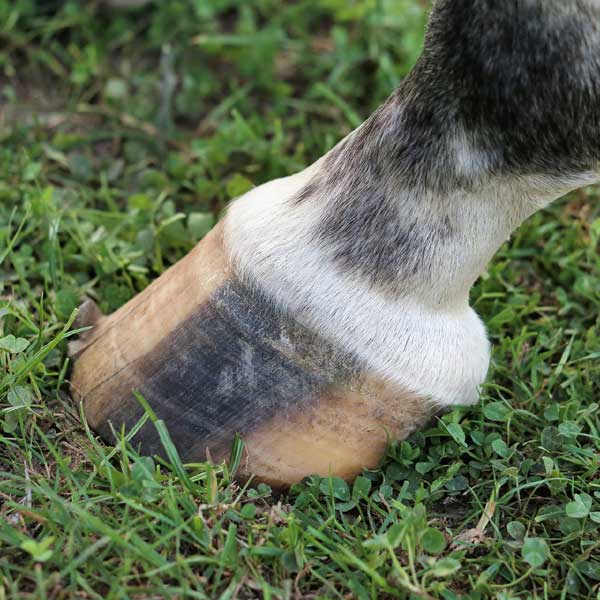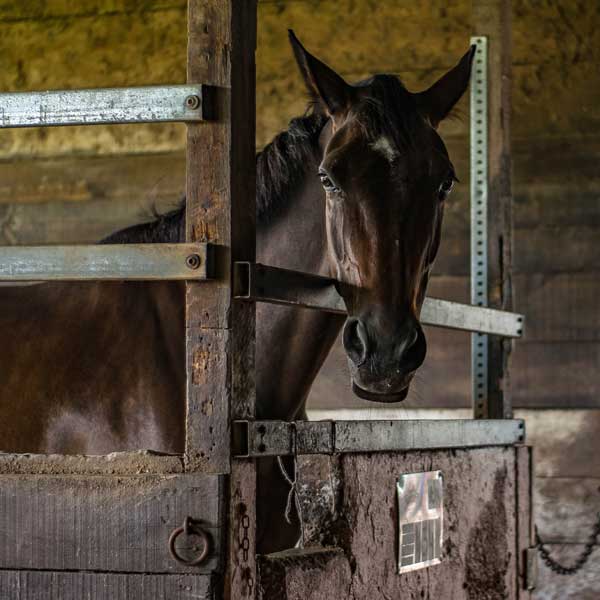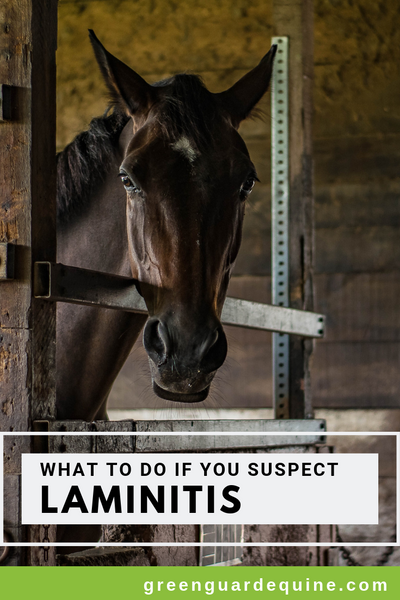There are many times in a horse owner’s life that create moments of panic. Most of these situations are related to possible colic or hoof issues. If your horse is showing any early signs of laminitis or colic, the first thing you should do is call your equine veterinarian. One troubling aspect of horse hoof care is that problems run the gamut from “no big deal” to “life threatening” and very often they look the same.
What do horse hoof problems look like?
- In the case of laminitis, an abscess, or a bruise, you might find an increased digital pulse. This alerts you to a pain or inflammation in your horse’s hoof.
- You might find your horse is tender-footed, unwilling to turn easily, or reluctant to step on harder ground.
- Your horse might be visibly lame or he may be reluctant to pick up a hoof for cleaning.

If you believe there's a serious problem with your horse's hoof, don't panic. Photo by GoranH on Pixabay.
Are there natural treatment methods in cases of possible hoof disease?
Because several hoof issues, including laminitis, look the same, a call to your vet is a good idea. Your vet, and only your vet, can accurately confirm a hoof disease diagnosis. They are also the only horse health professionals who can prescribe the proper treatment options -- such as pain medication -- to help your horse be more comfortable.
After you’ve called your equine vet, there are several things that you can do to care for your horse. Keep in mind that these methods of natural hoof care are only palliative. They can help you make and keep your horse at ease until the vet arrives, but they cannot treat or cure the underlying condition.
Since the vet might not be able to make an emergency call, these approaches are geared towards helping your horse through a few uncomfortable days.
Steps to follow for palliative horse hoof care:
- Calm your horse: Keep your horse as quiet as possible. If he is having trouble walking, provide him with nearby soft ground to rest on. Surface alternatives include mats, a sandy paddock, or an arena if one is available.
-
Changes to feed: Remove the horse from any feed that could be a laminitis trigger. Keep him off grass, and do not offer him bagged feeds or treats. Any other high sugar feeds that are part of his normal diet should not be allowed.

Social interaction is necessary to keep a horse calm. Make sure he can still see his stablemates. Photo by fortothom972 on Pexels.
- Ice: Get your horse’s feet into some ice. Chilling his hooves for 48-72 consecutive hours is the best thing you can to do for possible or actual laminitis. Not only does this assist with pain relief, it also works against the potentially deadly inflammation inside the hoof causing all of the discomfort. If you can, also chill the horse’s lower legs.
- Water: Make sure your horse has ready access to fresh water at all times.
- Social comforts: Make sure he can see his horse friends. Keeping his stress level down is key, and being able to see or interact with herdmates is an important part of that.
- Keep track of vitals: TPR -- Temperature, Pulse, and Respiration -- are the three most important vital signs to monitor until your vet arrives. Make regular note of your horse’s vital signs frequently to check for pain levels. Heart rates and respiration rates often rise when a horse is experiencing pain. Also include the digital pulse in all four legs. Keeping a record can give your vet a head start on the situation.
- Self-care: Take a few moments for you. Try not to panic or fear the worst! Deep breathing, clear thinking, and following your vet’s advice will help you stay strong for your horse.
Finally, don’t administer any prescription or over-the-counter pain medications until your vet has advised you to do so. Pain medications can interfere with a proper diagnosis and may even cause other issues depending on your horse’s condition. That initial phone call to your vet should include a discussion about what you can do for pain relief while your vet is en route.
What to do when the vet arrives
As we’ve just outlined, the more you can tell your equine vet about the condition of your horse, the better equipped they’ll be to proceed with making a diagnosis. First, the basics: temperature, pulse, respiration rate, and digital pulse. Making these TPR observations a habit now can ready you for a hoof care emergency later. If you do, you can also give your vet some benchmarks regarding your horse’s normal healthy resting values for comparison.
Provide your vet with an outline of your horse’s dietary and exercise routine. Be ready to tell the vet exactly what your horse eats, including how many carrots and apples he gets each day. What are his exercise habits? How many hours of pasture turnout does your horse get on a daily basis? How active is he? Have you noticed any dramatic changes in his weight or attitude recently?

The more useful information you can gather, the better prepared the vet will be when they arrive. Photo by wavebreakmedia on Shutterstock.
These day-to-day observations can all provide valuable pieces of the diagnostic puzzle, help your veterinarian reach a diagnosis, and determine treatment options with less delay. They can also help your vet decide whether X-rays are necessary, which can accurately identify an abscess, or pinpoint changes to the coffin bone that might indicate founder.
Beginning home treatment for horse hoof problems
Whatever diagnosis your veterinarian arrives at, be ready to get involved. Don’t be reluctant to ask how you should be supporting your horse’s recovery. Changes to food, turnout, stall rest, exercise, hand walking, and medications are all topics to discuss. Give your horse the best chance at recovering by noticing possible hoof diseases, including laminitis, early, and involving your veterinarian as soon as possible.
Liv Gude is the founder of Pro Equine Grooms, a community devoted to the best in horse care.





